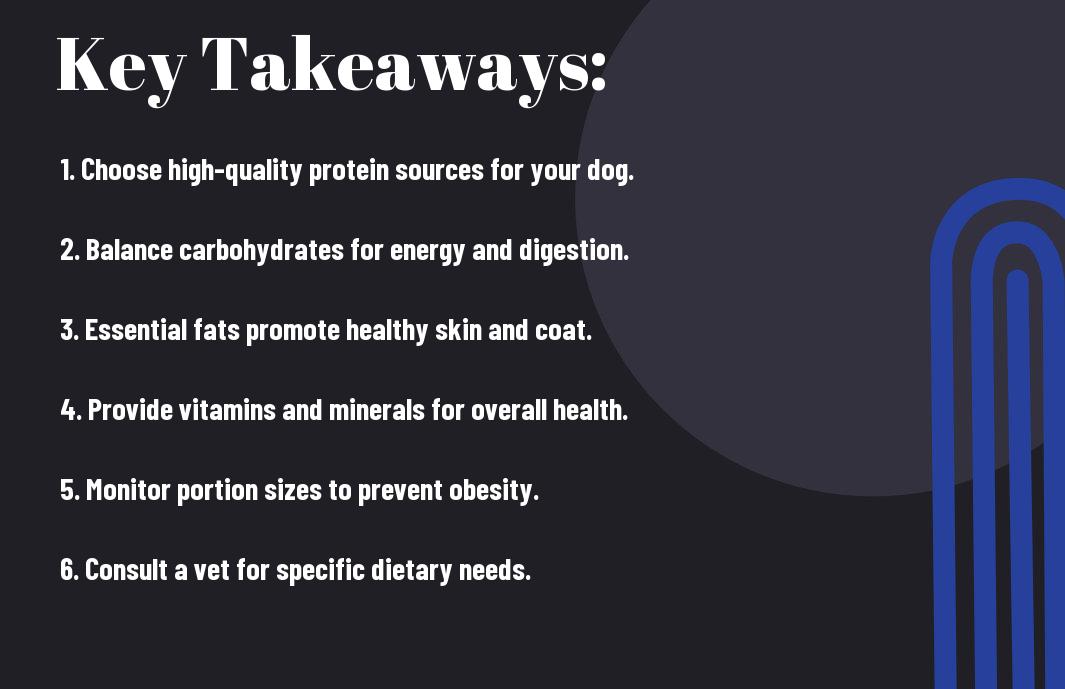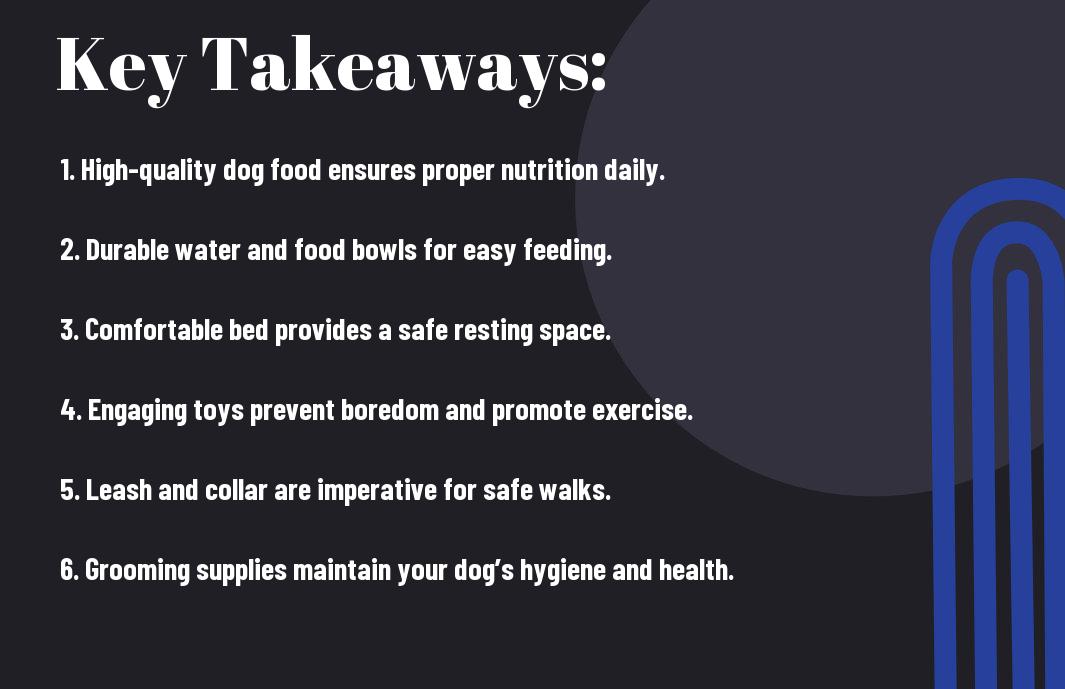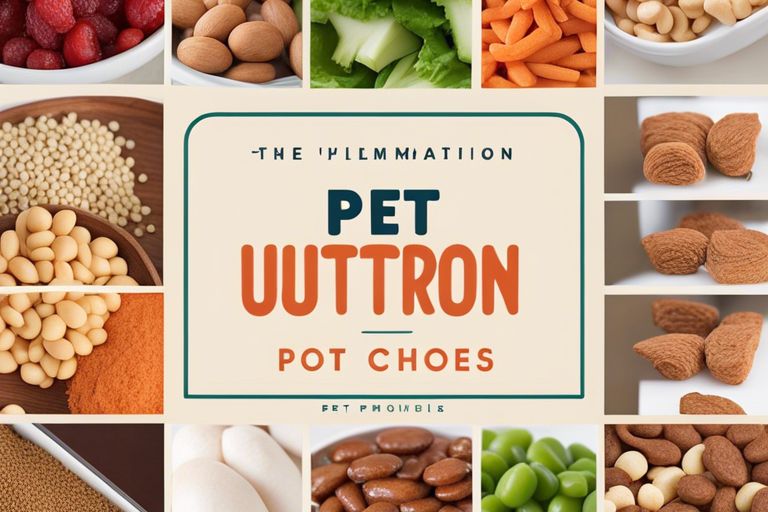You may not realize how important proper dog nutrition is for your furry friend’s overall health and well-being. Understanding what goes into your dog’s diet can help prevent serious health issues, improve energy levels, and support a shiny coat. It’s vital to choose a balanced diet that includes the right mix of proteins, carbohydrates, fats, vitamins, and minerals. In this post, we will explore the basics of dog nutrition, offering insights on how to make informed decisions for your pet’s dietary needs.


Understanding Dog Nutrition
Your dog’s nutrition is fundamental to their overall health, energy levels, and longevity. Providing your canine companion with a balanced diet tailored to their specific needs can mean the difference between a thriving pet and one that struggles with health issues. By understanding the principles of dog nutrition, you empower yourself to make informed choices that benefit your furry friend in the long run.
The Importance of Nutrition for Dogs
Below the surface of cute faces and wagging tails lies the necessity of proper nutrition. A well-balanced diet plays a vital role in maintaining your dog’s physical health, supporting immune function, and promoting optimal growth and development. Quality nutrition can also positively impact your dog’s emotional state, helping to reduce anxiety and behavioral problems.
Above all, good nutrition is the foundation for a happy, active, and disease-free life. Just as you rely on a balanced diet to maintain your own health, your dog requires a similar commitment to nutrition to ensure they flourish throughout their life.
Nutritional Requirements by Life Stage
For your dog, specific nutritional requirements change as they progress through different life stages. Puppies, adults, and senior dogs all have distinct dietary needs that should be met to support their overall health. For instance, puppies need diets rich in protein and fatty acids to fuel their rapid growth and development, while adult dogs demand a more balanced nutrient profile to maintain their energy levels and sustain their body condition.
Requirements also differ between active and less active dogs, and factors such as breed, size, and health conditions can further influence the specific needs your dog has. Always consult with your veterinarian to tailor your dog’s diet based on their unique life stage and lifestyle.
Common Nutritional Myths
Importance of understanding common nutritional myths cannot be overstated. Many dog owners operate under misconceptions that can lead to improper feeding practices and consequently impact their dog’s health negatively. For example, the myth that all dog food is created equal can result in choosing lower-quality options that lack necessary nutrients, leading to health issues.
Additionally, there is a pervasive belief that feeding your dog table scraps is fine, but this can contribute to obesity and other health problems, as most human food is not suitable for canine consumption. You should be diligent in educating yourself about your dog’s nutritional needs to avoid falling victim to these widespread myths.
But not all information about dog nutrition is accurate, and it’s necessary to seek reputable sources when determining what to feed your pet. Cross-reference your findings with your veterinarian or a pet nutritionist to ensure that your decisions support your dog’s health and well-being.
Macromolecules in Dog Food
Assuming you want to provide your dog with a balanced diet, understanding the macromolecules in dog food is fundamental. These macromolecules—proteins, fats, and carbohydrates—play pivotal roles in your dog’s health and well-being. Each of these components offers distinct benefits that cater to your dog’s nutritional needs, ensuring they thrive both physically and mentally.
Proteins: The Building Blocks
Before delving into specifics, it’s important to recognize that proteins are the building blocks of your dog’s body. They are vital for the growth, maintenance, and repair of tissues. Proteins consist of amino acids, some of which are termed important because your dog cannot produce them on its own and must obtain them through their diet. Therefore, high-quality protein sources such as chicken, beef, and fish are crucial in promoting your dog’s overall health.
When dicking out dog food, make sure that the protein content is adequate for your dog’s size, age, and activity level. A protein-rich diet can help support muscle development, immune function, and a shiny coat. Insufficient protein can lead to various health issues, including muscle loss, weakened immune response, and a dull appearance. Thus, prioritizing quality protein in your dog’s diet is important for maintaining their vitality.
Fats: Energy Sources and Benefits
One important macromolecule in dog food is fat. Fats are crucial sources of energy that promote healthy skin and a lustrous coat while assisting in the absorption of fat-soluble vitamins. They come in two main types: saturated and unsaturated fats. While both serve important functions, unsaturated fats are typically considered healthier and are found in oils such as fish and chicken fat. A balanced amount of fat provides your dog with the energy they need, especially for active pets.
Additionally, fats play a significant role in maintaining your dog’s cell membranes and supporting overall cellular function. It’s important to provide your dog with a diet that includes an appropriate amount of fats because too little fat can lead to energy deficiency, while an excess can result in obesity and other health complications. Striking the right balance is key in ensuring your dog remains healthy and active.
At the same time, you should be aware of the types of fats included in your dog’s food. Beneficial sources of fats will not only support energy needs but also contribute to cognitive functions and heart health. Therefore, look for dog foods that mention high-quality fat sources rather than fillers or by-products, ensuring the best for your furry companion.
Carbohydrates: Complex vs. Simple
About carbohydrates, these macromolecules are fractioned into two categories: complex and simple. Complex carbohydrates, such as brown rice and sweet potatoes, provide sustained energy and important nutrients, while simple carbohydrates, like white rice and sugar, give a quick energy boost but can result in rapid spikes in blood sugar. The right balance between these carbohydrates is important for maintaining your dog’s energy levels throughout the day.
It is also important to understand that while dogs can digest carbohydrates, their primary energy source should come from proteins and fats. Excessive carbohydrates, especially simple ones, may lead to weight gain and other health issues, such as diabetic conditions. Providing your dog with a diet that emphasizes complex carbohydrates can help ensure a steady energy supply while keeping their weight in check.
Blocks of carbohydrates play different roles in your dog’s diet, emphasizing the importance of choosing high-quality sources for sustainment and energy. By being mindful of the carbohydrates included in your dog’s food, you can support their energy levels while minimizing health risks associated with excessive simple carbohydrates.
Micronutrients and Their Roles
After understanding the macronutrients that form the backbone of your dog’s diet, it’s time to examine into the vital micronutrients, which play equally significant roles in maintaining their overall health. Micronutrients, including vitamins and minerals, are vital in small amounts and contribute to various physiological functions in your dog’s body. These nutrients support everything from immune function to bone health, making them indispensable in your pet’s dietary regimen.
Vitamins: Essential for Health
At the heart of your dog’s nutritional needs are vitamins, organic compounds required in small amounts for optimal bodily functions. Each vitamin has specific roles: for example, Vitamin A is vital for vision, whereas B vitamins are important for energy metabolism. Vitamin D aids in calcium absorption, promoting healthy bones and teeth. Because these vitamins cannot be synthesized in adequate quantities by your dog’s body, it’s important to provide them through a balanced diet or supplements when necessary.
Additionally, deficiencies in vitamins can lead to significant health issues, such as impaired immunity and skin problems. Thus, ensuring your dog receives a well-rounded source of vitamins, like fresh fruits and vegetables or high-quality dog food, will significantly benefit their long-term health and vitality.
Minerals: Bone Health and More
On the other hand, minerals assist in numerous vital bodily functions, including bone formation, fluid balance, and muscle contractions. Key minerals for your dog include calcium and phosphorus, which are vital for strong bones and teeth. Magnesium and potassium are also important for nerve and muscle function. It’s important to pay attention to the specific mineral requirements based on your dog’s size, age, and activity level.
The balance of minerals in your dog’s diet is crucial. Too much of one mineral can lead to imbalances that might affect overall health. For instance, excess calcium can result in orthopedic issues, particularly in growing puppies. To prevent this, consult with your veterinarian to ensure your dog receives the right balance of minerals through their diet or additional supplements if necessary.
Nutraceuticals: Beyond Basic Nutrition
To support your dog’s health beyond basic nutrition, nutraceuticals can be a powerful addition to their diet. These supplements are derived from food sources and are designed to provide health benefits that exceed basic nutritional needs. This category includes fatty acids, probiotics, and antioxidants, each offering unique advantages such as improved skin health, enhanced gut function, and reduction of oxidative stress.
Incorporating nutraceuticals may be particularly beneficial for older dogs or those with specific health concerns. Always consult with your veterinarian before introducing any new supplements to ensure they align with your dog’s current health status and dietary needs.
Due to the extensive range of available nutraceuticals, choosing the right ones can be overwhelming. It’s vital to select high-quality products backed by research, as not all supplements are created equal. This way, you can help ensure that you are providing the best possible support for your dog’s health and well-being.
Types of Dog Food
Not all dog food is created equal. Understanding the different types of dog food available can help you make the right choice for your furry friend’s dietary needs. Here are some common types of dog food:
- Commercial Dog Food
- Home-Cooked Diets
- Raw Diets
- Specialty Diets
- Limited Ingredient Diets
The right type of dog food depends on factors such as your dog’s age, health status, and preferences.
| Type | Description |
|---|---|
| Commercial Dog Food | Available in dry, wet, and raw forms, these products are designed to meet the nutritional needs of dogs. |
| Home-Cooked Diets | These diets consist of food prepared at home, allowing you control over ingredients. |
| Raw Diets | Focused on feeding raw meat, bones, and some raw fruits/vegetables that mimic a natural diet. |
| Specialty Diets | Formulated for specific health conditions or dietary needs, aiding in weight management, allergies, etc. |
| Limited Ingredient Diets | Contains fewer ingredients to minimize allergens and promote digestion. |
Commercial Dog Food: Dry, Wet, and Raw
Below, you can explore the various forms of commercial dog food, each having distinct characteristics and benefits. Dry food is convenient and shelf-stable, often providing a good balance of nutrients while promoting dental health through chewing. Wet food provides additional moisture, making it an excellent option for dogs that may need more hydration or have dental issues that make chewing difficult. Raw dog food typically consists of uncooked meat, bones, and fresh vegetables, appealing to those who advocate a more natural approach to canine nutrition.
Each type of commercial dog food comes with its own set of advantages and drawbacks. Dry food is less expensive and has a longer shelf life, while wet food can be pricier but is often more palatable and easier for your dog to eat. Meanwhile, raw diets can require significant preparation and careful balancing to ensure all nutrients are included. Taking the time to evaluate your dog’s specific needs can help you choose the best option.
Home-Cooked Diets: Pros and Cons
Beside commercial dog food, some pet owners opt for home-cooked diets. Below are the pros and cons of this approach to consider:
Pros and Cons
| Pros | Cons |
|---|---|
| Control over ingredients | Time-consuming to prepare |
| Customization for dietary needs | Difficulty in balancing nutrients |
| Better quality control | Need for meal planning |
| Potential for improved health | More expensive than commercial options |
| Ability to avoid allergens | Limited variety may lead to boredom |
Further, home-cooked diets can be tailored to your dog’s specific health needs. However, this approach can be challenging, as it’s important to ensure that your dog receives a balanced diet that meets all nutritional requirements. Working with a veterinarian can be beneficial in creating a suitable meal plan that keeps your dog’s health in check.
Specialty Diets: Allergies, Weight Management, and Specific Health Issues
At some point, your dog may face specific health issues that require a tailored nutritional approach. Specialty diets are designed for dogs dealing with allergies, weight management, or a variety of health concerns. These diets contain limited ingredients or specific formulations aimed at alleviating symptoms while ensuring adequate nutrition.
Commercial specialty diets often come with formulations aimed at managing various conditions, such as low-calorie foods for weight management or hypoallergenic diets for sensitive stomachs. Access to a veterinarian or a pet nutrition expert is key in selecting and implementing these diets correctly to ensure they align with your dog’s health needs.
Commercial dog food offers an array of options that can significantly benefit your pet’s health and well-being while specialized diets cater to specific conditions. It’s important to consider your dog’s unique needs and consult with a professional when making dietary changes.

Reading Dog Food Labels
Many pet owners feel overwhelmed when it comes to interpreting dog food labels. However, understanding how to read these labels is vital to selecting the best food for your furry friend. Each label provides insights into the ingredients, nutritional value, and overall quality of the diet that will affect your dog’s health and well-being.
Understanding Ingredients Lists
Between the myriad of ingredients listed on a dog food label, you may find it challenging to discern what is beneficial or harmful for your pet. Pay close attention to the first few ingredients, as they are the primary components of the food. Generally, a quality dog food will begin with recognizable sources of protein, such as chicken, beef, or fish. Additionally, a variety of whole grains, fruits, and vegetables can indicate a balanced diet, while by-products or fillers like corn or wheat often suggest lower quality.
It is also imperative to look for ingredients that provide specific nutritional benefits. For instance, ingredients like sweet potatoes or peas can offer valuable nutrients and fiber. However, be cautious of vague terms or artificial additives that can detract from your pet’s diet. By familiarizing yourself with the primary ingredients, you can ensure that the food you choose aligns with your dog’s specific dietary needs.
Deciphering Nutritional Adequacy Statements
Reading the nutritional adequacy statement on a dog food label helps you identify whether the product meets all the necessary dietary requirements for your pet. Generally located on the back or side panel, this statement indicates if the food is formulated to meet the standards set by the AAFCO (Association of American Feed Control Officials). Look for phrases such as “complete and balanced” since this means that the food has been tested and deemed suitable for your dog’s life stage.
This statement is imperative because it acts as a guideline for what your dog needs based on their age, weight, and activity level. While many brands do adhere to these standards, remember to consider the quality of the ingredients as they can vary significantly, impacting the overall nutritional value. Always take the time to understand the label to maximize your dog’s health.
Common Industry Terms Explained
Lists of terms found on dog food labels may often confuse you, but familiarizing yourself with these common industry phrases can help you make better choices. Terms like “grain-free” or “natural” have specific meanings and may indicate a product’s formulation, but they don’t always guarantee that the food is the healthiest option for your dog. For example, “grain-free” does not automatically mean the food is better, as it may simply be replaced with alternative fillers.
Furthermore, the use of terms like “human-grade” suggests high-quality ingredients, yet it may not always be the best criteria for deciding on a dog food brand. Understanding these terms can equip you with the knowledge needed to navigate through marketing jargon and ultimately help you prioritize your dog’s health through informed choices.
Ingredients that are explicitly defined will clarify what is in your dog’s food and ensure that you are providing a nutritious diet. When you explore into these terms, you will be better positioned to select a dog food that not only meets the nutritional standards but also suits your dog’s specific dietary needs and preferences.
Portion Control and Feeding Guidelines
Despite the overwhelming amount of information available about dog nutrition, understanding how to effectively manage your dog’s portions is crucial for their overall health. Portion control helps prevent obesity, ensures that your pet is receiving the right nutrients, and promotes a healthy lifestyle. To make informed decisions, it is important to consider factors such as your dog’s age, size, activity level, and breed when determining their food intake.
How to Determine Appropriate Portions
One of the best ways to determine appropriate portions for your dog is to refer to the feeding guidelines provided on the dog food label. These guidelines typically suggest daily serving amounts based on your dog’s weight and life stage. However, these recommendations can vary among different brands, so it’s vital to adjust according to your dog’s specific needs and consult your veterinarian for personalized advice.
Additionally, you should observe your dog’s body condition to further refine their portion sizes. A lean, well-proportioned dog should have a defined waist and be able to feel their ribs without excess fat. If your dog appears overweight or underweight, you may need to adjust their portion sizes accordingly. Keeping a diary of your dog’s weight and how they respond to their feeding schedule will also help you fine-tune their diet.
Establishing a Feeding Schedule
Portions alone are not enough; establishing a consistent feeding schedule is just as important for your dog’s well-being. You should aim to feed your dog at the same times each day, whether it’s twice a day or on a free-feeding basis. This consistency aids in digestion and can help your pet anticipate mealtime, making them more relaxed and content.
Further, consider breaking their daily food allowance into smaller, more frequent meals, especially for younger puppies. This approach not only helps maintain energy levels throughout the day but also reduces the risk of digestive issues such as bloat and creates a routine that can help with training.
Recognizing Signs of Overfeeding or Underfeeding
At times, it can be challenging to gauge whether you are properly feeding your dog. Signs of overfeeding include excessive weight gain, lethargy, and difficulty getting up or engaging in physical activity. On the other hand, underfeeding may manifest as rapid weight loss, a noticeable ribcage, or a dull coat. By keeping an eye on these indicators, you will gain valuable insights into your dog’s dietary needs and be able to adjust their meals accordingly.
Signs of overfeeding may not only affect your dog’s appearance but can also lead to serious health problems, such as diabetes or heart disease, which can drastically affect their quality of life. Conversely, underfeeding your dog puts them at risk of malnutrition, which can lead to weakness, behavioral issues, and an increased susceptibility to infections. Being proactive in monitoring your pet’s health and adjusting their portions can help you avoid these dangerous conditions.
Summing Up
Presently, you have gained a foundational understanding of dog nutrition and its significance in maintaining your dog’s overall health and well-being. By grasping the necessarys of a balanced diet, you can make informed choices that support your dog’s specific needs, taking into account factors such as age, breed, and health conditions. This knowledge empowers you to select the right foods and supplements, ensuring that your furry companion receives the appropriate nutrients to thrive.
Moreover, being aware of the potential dangers of improper nutrition, such as obesity or dietary deficiencies, equips you to prevent common health issues in your dog. By taking the time to educate yourself and regularly consulting with your veterinarian, you will be well-prepared to create a personalized dietary plan that keeps your dog happy, energetic, and healthy throughout their life. Prioritizing your dog’s nutritional needs will not only enhance their quality of life but also strengthen the bond you share.
FAQ
Q: What are the main components of a balanced dog diet?
A: A balanced dog diet typically consists of proteins, carbohydrates, fats, vitamins, and minerals. Proteins are imperative for muscle development and overall health, while carbohydrates provide energy. Fats are necessary for healthy skin and coat, and they also serve as a concentrated energy source. Vitamins and minerals support various bodily functions, such as immune support and bone health. It’s important to ensure that these components are present in appropriate ratios to meet the specific needs of your dog based on their age, size, activity level, and health status.
Q: How can I determine the right food portion for my dog?
A: To determine the right food portion for your dog, consider factors such as their age, weight, activity level, and any specific dietary needs they may have. Most commercial dog food packaging provides feeding guidelines based on weight. Additionally, taking your dog to the vet for a check-up can help assess their body condition and nutritional needs. Monitoring your dog’s weight and making adjustments as needed can also help you fine-tune their portion sizes. Ensuring your dog maintains a healthy weight is imperative for their overall well-being.
Q: Are there any specific foods I should avoid giving my dog?
A: Yes, there are several human foods that should be avoided in a dog’s diet as they can be harmful. Common foods to avoid include chocolate, grapes, raisins, onions, garlic, and avocados, as these can cause various health issues ranging from digestive upset to more serious conditions. Additionally, excessive amounts of fat, sugar, and salt can lead to health problems. It’s best to consult your veterinarian for a comprehensive list of foods that are safe and unsafe for dogs, as well as tips on healthy treats.










